Student activist movements at the University of Toronto, and perhaps throughout Canada, have been on the decline in recent years. Turnout rates have fallen, messages have become co-opted, and over time, student movements have had their signals crossed. The following headlines and snapshots have been pulled from the pages of The Varsity from the 1970s to the beginning of 2010. The progression of time has seen a backwards slide in effective activism, as the once formidable force of opinionated students with an agenda has grown weak in its old age.
1970–1979
The Robarts sit-in | circa February–August 1972
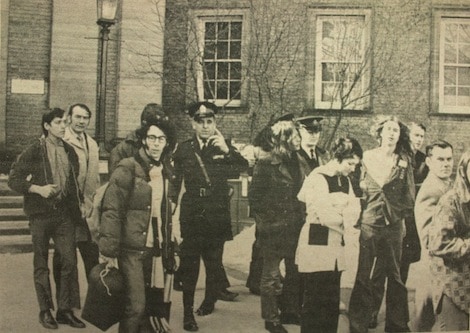
FRANK ROONEY/THE VARSITY
In 1972, Robarts library was the source of a year-long conflict between the university’s Governing Council and a particularly determined class of undergraduates. Access to the stacks was intended to be limited to faculty members, graduate students, and fourth-year undergraduates.
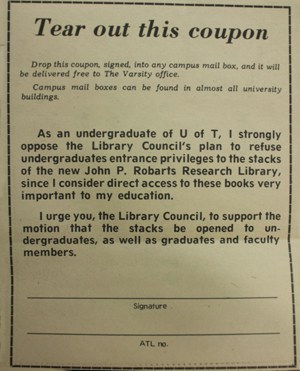 The plan to restrict undergraduate student access was not initially publicized on campus, says Linda McQuaig, then Editor-in-Chief of The Varsity. When The Varsity found out about the issue, it quickly became a hot topic of discussion on campus. After several weeks of coverage in the paper, a number of widely attended protests were organized by the Students’ Administrative Council (SAC), with support from the Graduate Students’ Union (GSU).
The plan to restrict undergraduate student access was not initially publicized on campus, says Linda McQuaig, then Editor-in-Chief of The Varsity. When The Varsity found out about the issue, it quickly became a hot topic of discussion on campus. After several weeks of coverage in the paper, a number of widely attended protests were organized by the Students’ Administrative Council (SAC), with support from the Graduate Students’ Union (GSU).
What began with the jailing of “about a dozen” students for staging a sit-in protest led to a heated stand-off as thousands of angry undergraduates filled Simcoe Hall for several hours. In the face of overwhelming pressure, the interim president of the university, Jack Sword, addressed the mob and capitulated on behalf of the administration.
“Tanaka comes and goes” | Wednesday, September 25, 1974
In 1974, Japanese Prime Minister Kakeui Tanaka visited U of T to receive an honorary degree and “toss off some finely-turned phrases on mutual solidarity” between Canada and Japan. Prime Minister Tanaka’s visit could not have been scheduled for a more inopportune time, as frustration over Japan’s whaling industry was boiling over on campus.
Then-sac President Seymour Kanowitch declined his invitation to a “special convocation and elaborate lunch” to make a statement about the controversial visit. Protestors gathered outside with signs and copies of The Varsity featuring a cover story on Japan’s whaling industry. One of the demonstrators took the opportunity to shove a copy into the Japanese prime minister’s hands as he moved through the crowd.
“OFS lobbies Queen’s Park” | Monday, November 19, 1979
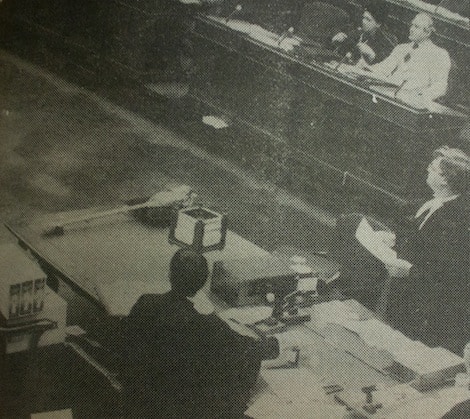
RANDY WINTER/THE VARSITY
At the close of the decade, the Ontario Federation of Students (OFS) mobilized to present a petition to the Ontario Legislature bearing 12,000 signatures from students in the province. The lobbying effort represented a follow-up to the widely circulated postcard campaign that started earlier that year. The petition was presented in the House by ndp education critic David Cooke on behalf of the ofs, and contained a number of recommendations for addressing the issues of accessibility and quality of education plaguing the post-secondary system in the province.
Over the course of the day, 100 students representing post-secondary institutions in Ontario met with roughly two-thirds of the mpps in the house to discuss their grievances. Members were asked by the ofs to write to their party’s leadership, as well as Dr. Bette Stephenson, the Minister of Colleges and Universities, in order to get the message out.
In a press conference after the presentation, OFS president Chris McKillop said: “At the outset we stated that if the mass were to heighten the legislature’s awareness of post-secondary education, it would achieve our objective. That has been accomplished.”
1980–1989
“Students angry at Queen’s Park rally” | Wednesday, April 2, 1980
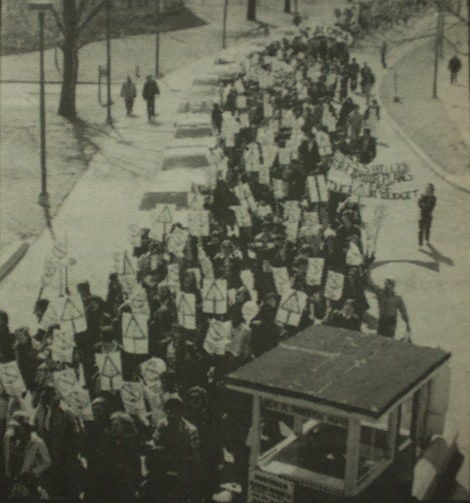
Unfortunately for the ofs, the previous year’s presentation to the Ontario legislature proved unsuccessful in the long run, as the province announced a hike in tuition fees in 1980. In response, the ofs organized a group of 2,500 to 3,000 students from “as far as Ottawa and Sault Ste. Marie” in a mass rally in Queen’s Park.
Outraged over the fee increase, as well as funding cutbacks and inadequate student aid, the large crowd demanded an audience from the province’s leadership. The protestors were addressed by a number of officials, some supportive, including Toronto Mayor John Sewell, who took the opportunity to whip the mob into a fervour by claiming solidarity with their cause.
“Students storm President’s office” | Thursday, March 5, 1987
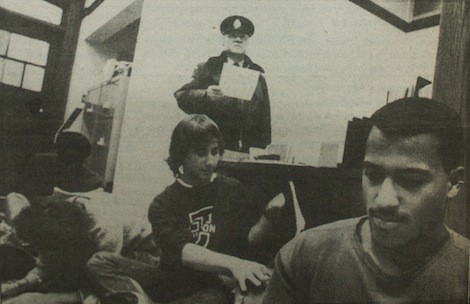
DAVID MALTBY/THE VARSITY
Employing the tried and true protest method of simply showing up somewhere, sitting down, and refusing to move, 28 students and one professor marched from the International Students Centre on St. George Street to U of T president George Connell’s office one day in early March 1987.
The group, representing U of T’s anti-apartheid network and several of its affiliate organizations, descended on president Connell’s office after a student motion to address the university’s policies toward apartheid South Africa was struck from a Governing Council meeting agenda.
As the group moved in to protest, it became clear that President Connell was not only absent from his office — he was out of the city. Members of the U of T administration described the group as being surprisingly well-behaved. Jack Dimond, Governing Council Secretary and acting university spokesman, was visibly unimpressed by the performance, remarking: “I’m calm; I’m a child of the sixties.”
“U of T abortion activists continue to speak out: Pro-life rally at birth-control centre” | Monday, November 20, 1989

MIKE RANDOLPH/THE VARSITY
Braving what was described as below freezing temperatures as November shifted into December, 40 pro-life students under the “Students for Life” banner congregated outside the front steps of the Bay Centre for Birth Control, bearing signs depicting graphic images of aborted fetuses.
The group’s demonstration was characteristically Canadian, as the picketers let people enter and exit the building without confrontation. The only instance of public disturbance occurred during a minor shouting match between the placard carrying students and a group of pro-choice pedestrians who happened to walk by. While the centre did not actually perform abortions in house, it was the largest abortion referral centre in Canada at the time.
1990–1999
“Low turnouts highlight underfunding rallies” | Monday, October 21, 1991
One of the most chronic issues affecting well-intentioned activism has always been public apathy. Such was the case in 1991, when a measly 70 students turned out for a SAC rally against provincial underfunding of universities.
Representing .002 per cent of U of T’s 36,000 undergraduates at the time, the attending activists’ message suffered from being partially funded by the university administration. After resigning over a disagreement on how best to protest funding cuts to post-secondary education in Ontario, SAC external commissioner Stacey Papernick lamented, “I wish they didn’t fund this project. It compromised how we lobbied. If it’s going to tie my hands, I don’t want the money.”
Despite attempts to put up an “underfunding graveyard” of courses at U of T lost to funding cuts, the group could not overcome the unpalatable association with U of T higher-ups.
“Arrests rock PM’s visit” | Tuesday August 10, 1993
Canada’s first and only female prime minister, Kim Campbell, was scheduled to have a private meeting with several Toronto Conservative MPs during her first official visit to U of T. Her plans were frustrated when a dedicated group of students managed to break past a police line and into the meeting room at Hart House.
The students’ forceful move precipitated a swift unraveling of political decorum on the part of both the protestors and campus police. The protestors were violently expelled from Hart House with a number being arrested outside for assaulting police. The purpose of the protest was completely dwarfed by the circus-like method in which it was executed. All legitimacy was lost once the students resorted to force and the handcuffs came out.
“Massive demonstration against funding cuts held” | Monday, January 30, 1995

SAMANTHA RAJASINGHAM/THE VARSITY
“What a sight this is to see,” SAC President Gareth Spanglett announced over the microphone at the podium in Convocation Hall, as he looked over the mass gathering of students collected to observe the national student strike and day of action.
The crowd in front of Spanglett consisted of 4,000 interested undergraduates who had come to hear a series of student leaders and faculty members speak on the federal government’s proposed elimination of $2.6 billion in cash reserve payments to colleges and universities nation-wide. Outside of Convocation Hall stood an additional 2,000 students eagerly listening in on the event over speakers.
After departing from the hall, the group joined forces with contingents from other metro Toronto universities to take part in a collective rally that drew 10,000 people. The day of action saw the mobilization of 40,000 students across Canada, each feeling as first-year student Cheryl Mapp described: “The strike is our only alternative. We tried negotiation, we tried reason. Students have tried to do things logically, but at this point, this is the only way students are going to get any notice.”
2000–2009
“Students rally as Rae Report looms” | Monday, February 7, 2005
In anticipation of an announcement from the Ontario government that tuition fees were to be increased, a number of student activists from across the province were joined in front of Convocation Hall by a group of Ontario workers to march to the steps of Queen’s Park in the frigid February air. The cold crowd was emboldened by a series of addresses from provincial politicians expressing solidarity, including NDP leader Howard Hampton who called for “a ten per cent reduction, right off the bat.”
The spirit of the crowd was best summed up by Ryerson student Katie Mayerson, who said: “I’m hoping that people are looking out their windows and seeing this and understanding that people are skipping classes that they paid for, because this is really important to them.” Rather than the bitter attacks or moral superiority exemplified by earlier student protests, it would seem that the best students hope for in the new millennia is a little attention.
“Turnout drops for Drop Fees” | Monday, November 9, 2009
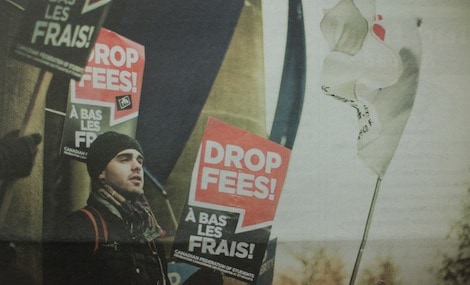
REMI CARREIRO/THE VARSITY
With tuition fees rising annually for the past several years, it comes as no surprise that student movements have had to reexamine their demands when it comes to petitioning the government for affordable education. In the past, students may have demanded bold cuts to the costs of post-secondary education — but compromise has apparently become the modern method of negotiation.
The loss of a strong position, combined with decreased turnout rates for events, has sapped student activism at U of T of all leverage. This was certainly the case in 2009 when the CFS attempted to direct a crowd to parade in protest for a poverty-free Ontario as part of their annual Drop Fees campaign. Predictably, the event drew anemic numbers as many students opted to spectate rather than participate.
Looking ahead
In order for student movements at U of T and in Canada to return to the glory days of worthwhile protest, a fundamental change must take place in the collective student psyche. Where we are disorganized, we must come together. Where we disagree, we must find common ground, lest we undo ourselves from within. Our messages need to be better articulated and to be spoken with louder voices. This change will require a sober recognition of the important issues — the things that matter to all of us — and a renewed dedication to being heard.


